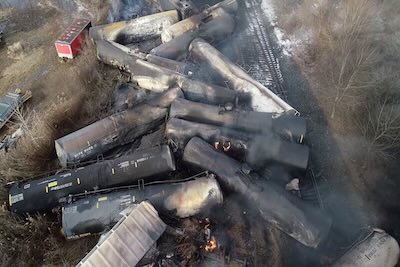Download PDF
RCA TRAINING
Root Cause Analysis training by Sologic provides the tools, skills, and knowledge necessary to solve complex problems in any sector, within any discipline, and of any scale. Learn MoreSOFTWARE
Sologic’s Causelink has the right root cause analysis software product for you and your organization. Single users may choose to install the software locally or utilize the cloud. Our flagship Enterprise-scale software is delivered On Premise or as SaaS in the cloud. Learn MoreExecutive Summary:
On February 2, 2023, a Norfolk Southern freight train carrying hazardous materials derailed in East Palestine, Ohio, resulting in a chemical spill, environmental contamination, and the evacuation of approximately 2,000 residents. To prevent an explosion, a controlled burn of vinyl chloride was conducted.The East Palestine train derailment had significant immediate impacts, including hazardous chemical spills, environmental contamination, infrastructure damage, and the evacuation of approximately 2,000 residents. Financial costs are expected to exceed $800 million, covering cleanup, legal fees, health monitoring, and infrastructure repairs. Potential impacts could have been even more severe, with the risk of uncontrolled explosions, widespread public health crises, extensive environmental damage, larger evacuations, and major economic disruption for the region.
The derailment was traced to an overheated bearing in the 23rd car, which led to a catastrophic axle failure. Insufficient monitoring and inspection processes may have missed early signs of mechanical damage, lubrication issues, or component misalignment. The train lacked real-time monitoring systems for bearing temperatures, and a delayed alarm resulted in braking too late to prevent derailment.

This Root Cause Analysis (RCA) recommends the following solutions:
- Define minimum inspection time for critical components.
- Lower the bearing temperature alarm threshold.
- Install additional Hot Box Detectors along tracks.
- Equip railcars with continuous bearing monitors.
- Improve inspection processes and equipment.
- Implement real-time monitoring for immediate alerts.
- Enhance communication protocols between control centers and crews.
- Review and update hazardous material handling protocols.
- Invest in infrastructure upgrades to improve safety.
- Enforce stricter speed limits with monitoring.
- Strengthen emergency response plans with local authorities.
- Explore alternative transportation for hazardous materials.
These actions aim to build resilience by improving detection, response, and preventive measures, enhancing the safety of rail operations and protecting surrounding communities.
Note: Download the PDF for the full report